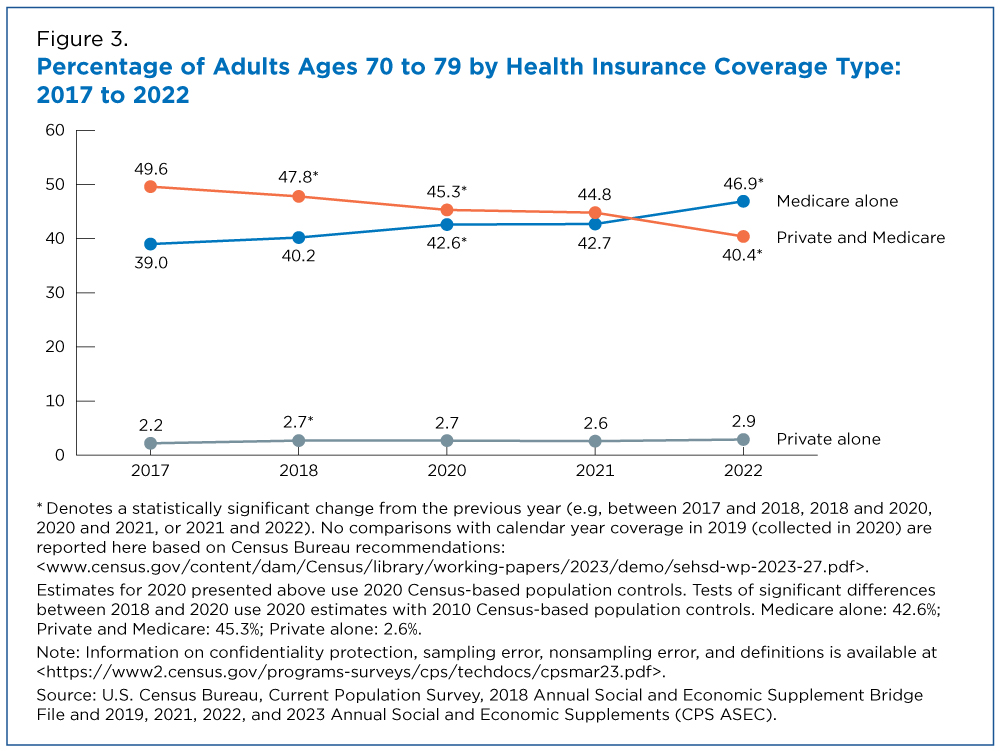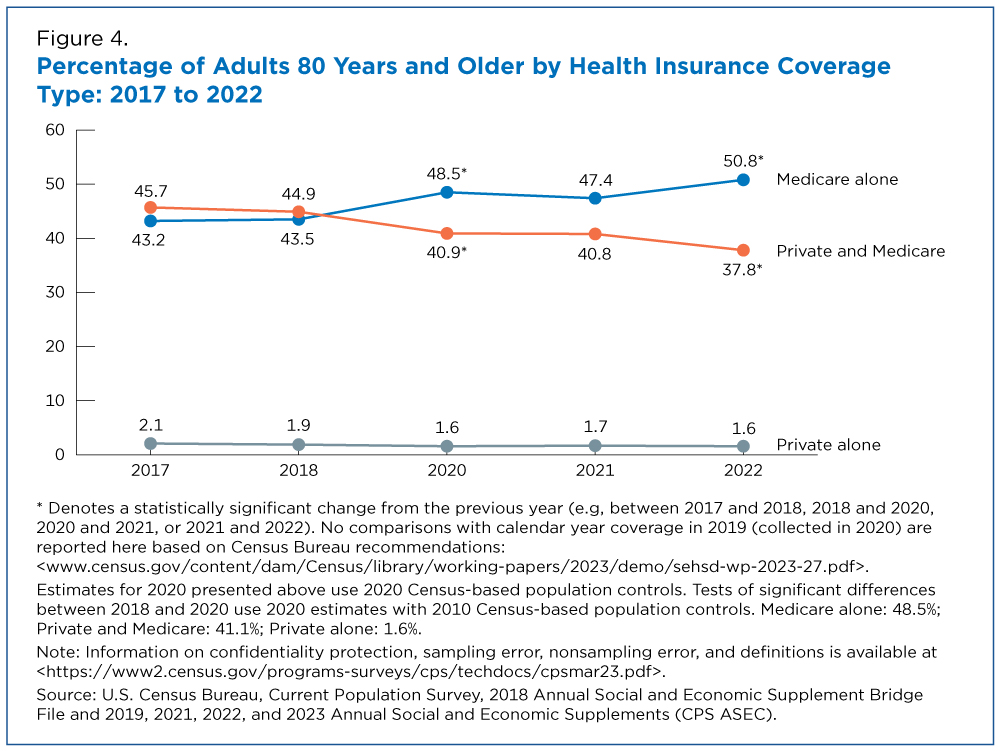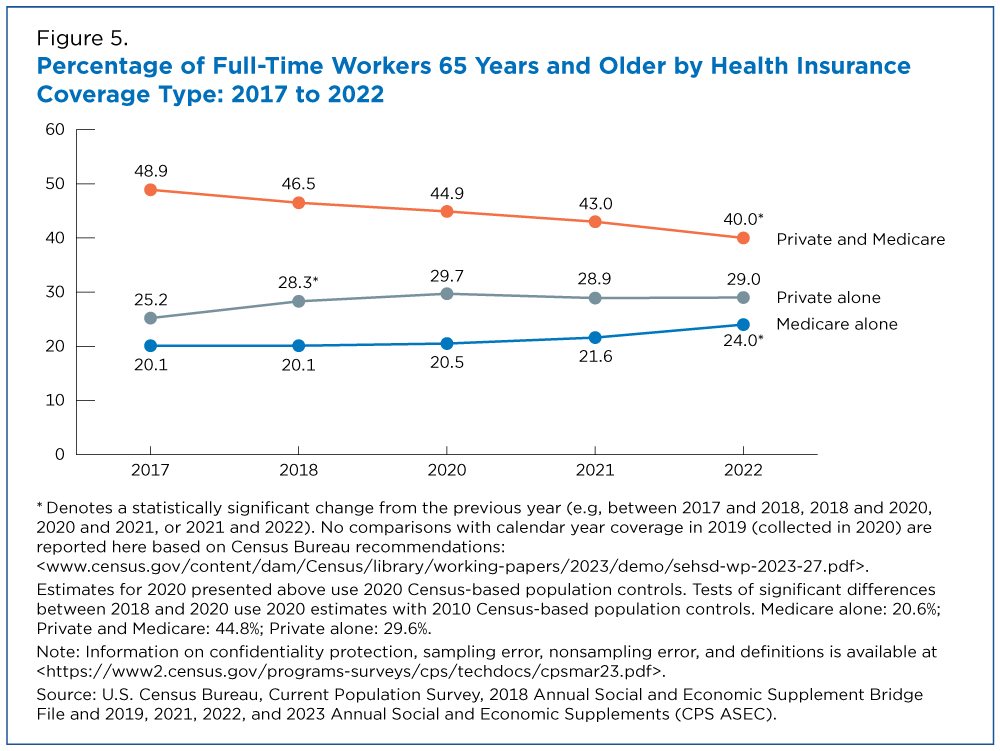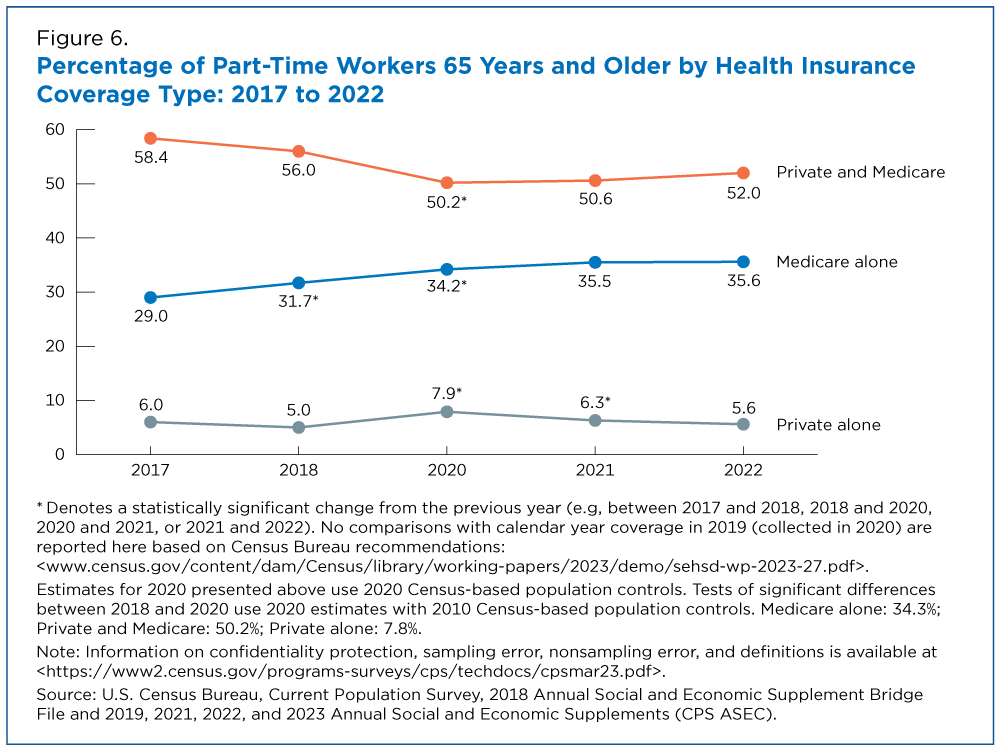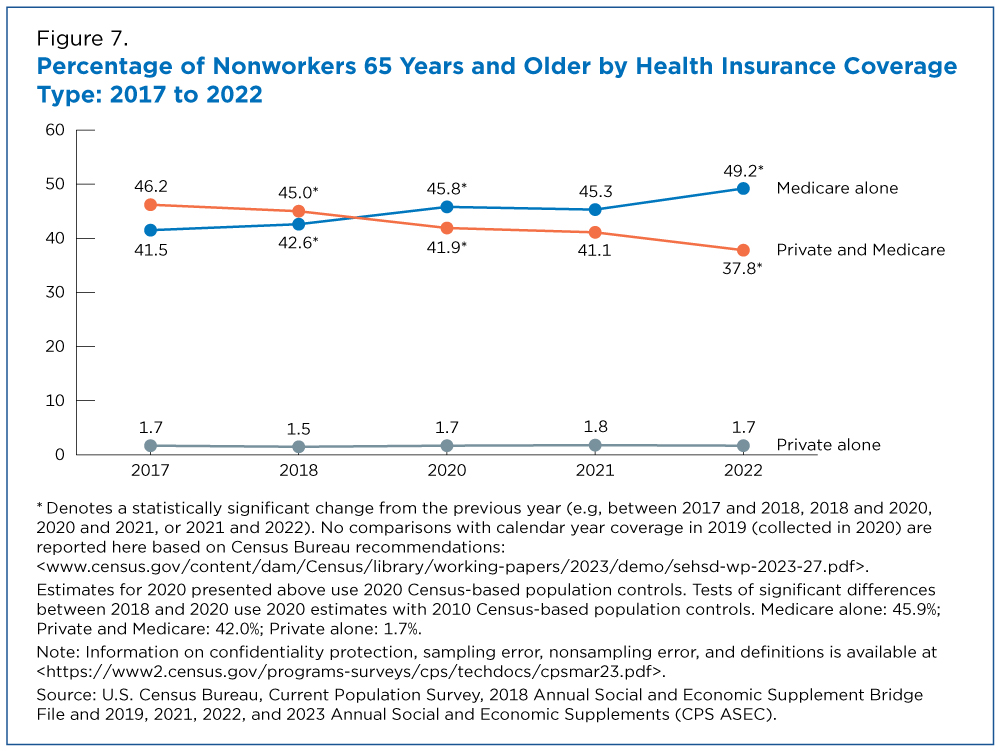Percentage of Older Adults With Both Private Health Insurance and Medicare Decreased From 2017 to 2022
The percentage of adults age 65 and older covered by both private health insurance and Medicare decreased from 47.9% in 2017 to 39.6% in 2022, reflecting older adults’ increased reliance on Medicare coverage alone.
Dual coverage rates decreased almost every year during that period, except from 2020 to 2021, while rates of Medicare coverage alone significantly increased during the same period, from 37.6% to 44.8%, according to a new analysis of data from the 2023 Current Population Survey Annual Social and Economic Supplement (CPS ASEC).
Similar to overall coverage rates for adults age 65 and older, all age groups within this population experienced decreases in dual private and Medicare coverage and increases in rates of Medicare coverage alone from 2017 to 2022.
Much of the increase in the share of older adults relying solely on Medicare was driven by a drop in the share of those also receiving private coverage.
In 2017, the percentage of adults age 65 or older who only had Medicare coverage was 10.3 percentage points lower than the percentage of those with both private and Medicare coverage. By 2022, the percentage with Medicare coverage alone was 5.2 percentage points higher than the percentage with dual coverage as fewer older adults reported supplementing their Medicare coverage.
The percentage of older adults who only had private coverage is small and has remained stable over time (4.9% in 2017 to 5.3% in 2022).
Medicare Coverage
Most adults age 65 and older qualify for Medicare coverage, the main reason coverage rates in that age group were 98.9% in 2022. A small percentage of them (9.2% in 2022) have additional types of public health insurance through the government besides just Medicare.
Some adults in that age group who are covered only by Medicare also choose to supplement it with private health plans. These plans offer additional medical benefits or a reduced cost for medical treatment.
The decline in private health coverage that occurred from 2017 to 2022 may affect the quality of medical care as well as access to providers for people in this age group.
Changes in Coverage by Age
Similar to overall coverage rates for adults age 65 and older, all age groups within this population experienced decreases in dual private and Medicare coverage and increases in rates of Medicare coverage alone from 2017 to 2022:
- Ages 65 to 69. Dual coverage decreased 8.0 percentage points and Medicare alone increased by 6.3 percentage points — the only older adults age group that did not experience higher rates of Medicare alone coverage than dual private and Medicare coverage.
- Ages 70 to 79. Dual coverage decreased 9.2 percentage points to 40.4% and Medicare alone increased 7.9 percentage points to 46.9%.
- Age 80 and older. Dual coverage decreased 7.9 percentage points to 37.8% and Medicare alone increased 7.6 percentage points to 50.8%.
Changes in Coverage by Employment Status
Because many people get private health insurance through an employer, adults age 65 and older who still work may find it easier to source affordable private coverage. However, the percentage of older adults with dual private and Medicare coverage decreased across all employment statuses from 2017 to 2022, while the rates of Medicare coverage alone increased:
- Older adults who worked full time. Dual coverage dropped 8.9 percentage points to 40.0% and Medicare alone increased 4.0 percentage points to 24.0%. These workers also saw an increase in private coverage alone from 25.2% to 29.0%, and full-time workers were the only group to have higher rates of private coverage alone than Medicare alone in 2022.
- Older adults who worked part time. Dual coverage decreased 6.3 percentage points to 52.0% but remained higher than Medicare alone, which increased 6.6 percentage points to 35.6%.
- Older adults age 65 and older who did not work. Dual coverage declined 8.4 percentage points to 37.8% and Medicare alone increased 7.7 percentage points to 49.2% — the only employment status group to have lower dual coverage rates than Medicare only rates in 2022. In 2017, dual coverage rates were 4.7 percentage points higher than those with Medicare alone. In 2022, the share with Medicare alone was 11.4 percentage points higher than the share with dual coverage.
More information on confidentiality protection, sampling error, nonsampling error and definitions is available in the technical documentation. All comparative statements in this article have undergone statistical testing and, unless otherwise noted, all comparisons are statistically significant at the 10% significance level.
Subscribe
Our email newsletter is sent out on the day we publish a story. Get an alert directly in your inbox to read, share and blog about our newest stories.
Contact our Public Information Office for media inquiries or interviews.
-
Business and EconomyHow Many U.S. Businesses Offer Health Insurance to Employees?February 29, 2024Private-sector companies in seven states and District of Columbia offer health insurance to employees at a rate significantly above the national average.
-
HealthAbout 43 Million People in the U.S. Had Multiple Health Plans in 2021July 19, 2023More than half of multiple coverage holders had Medicare and a private coverage plan.
-
HealthHealth Insurance Coverage of U.S. Workers Increased in 2022September 12, 2023Health insurance coverage for working-age adults ages 19 to 64 improved in 2022 across race groups and Hispanic origin and in most regions.
-
Business and EconomyExploring New Frontiers With the Quarterly Workforce IndicatorsJanuary 13, 2026New data on employment and hiring for detailed national industries enable data users to explore the composition and dynamics of specialized workforces.
-
Business and EconomyEconomic Census Highlights Variety of Products Many Industries SellJanuary 06, 2026North American Product Classification System (NAPCS) Data Release from the 2022 Economic Census is a treasure trove of unique information.
-
Business and EconomyRevenue and Employment Trends Reveal Shifts in U.S. EconomyDecember 30, 2025Revenue and employment losses in select retail industries continued, while online sales brokers and local delivery boomed.
-
EmploymentThe Stories Behind Census Numbers in 2025December 22, 2025A year-end review of America Counts stories on everything from families and housing to business and income.



